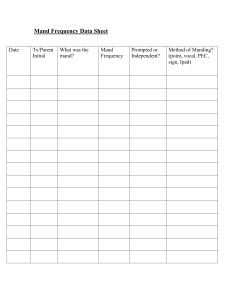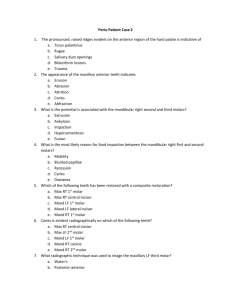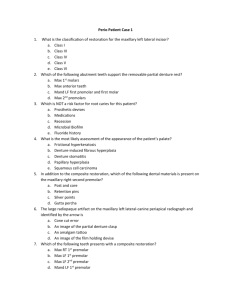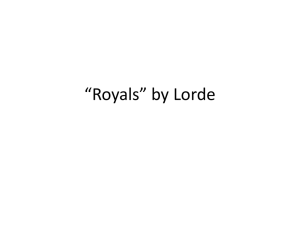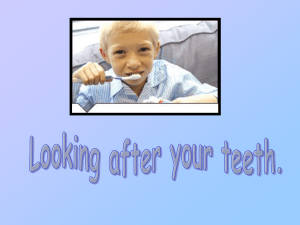Pedo Patient Case 2 Which of the following is the most likely
advertisement
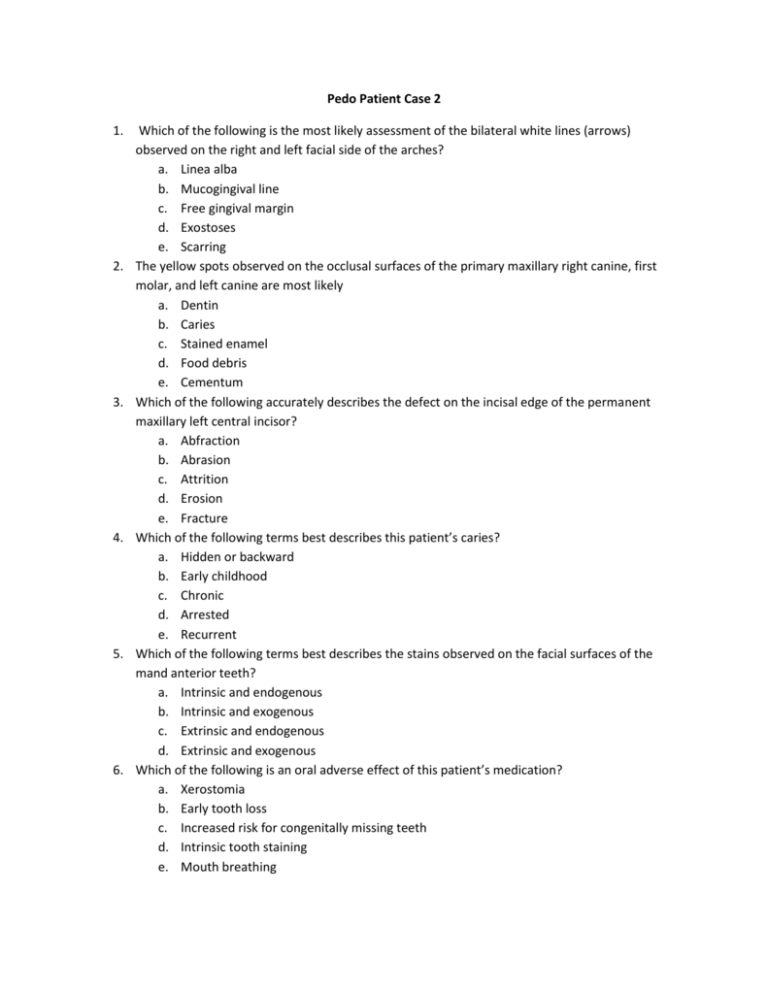
Pedo Patient Case 2 1. 2. 3. 4. 5. 6. Which of the following is the most likely assessment of the bilateral white lines (arrows) observed on the right and left facial side of the arches? a. Linea alba b. Mucogingival line c. Free gingival margin d. Exostoses e. Scarring The yellow spots observed on the occlusal surfaces of the primary maxillary right canine, first molar, and left canine are most likely a. Dentin b. Caries c. Stained enamel d. Food debris e. Cementum Which of the following accurately describes the defect on the incisal edge of the permanent maxillary left central incisor? a. Abfraction b. Abrasion c. Attrition d. Erosion e. Fracture Which of the following terms best describes this patient’s caries? a. Hidden or backward b. Early childhood c. Chronic d. Arrested e. Recurrent Which of the following terms best describes the stains observed on the facial surfaces of the mand anterior teeth? a. Intrinsic and endogenous b. Intrinsic and exogenous c. Extrinsic and endogenous d. Extrinsic and exogenous Which of the following is an oral adverse effect of this patient’s medication? a. Xerostomia b. Early tooth loss c. Increased risk for congenitally missing teeth d. Intrinsic tooth staining e. Mouth breathing 7. Which of the following terms best describes the stains observed on the facial surfaces of the mandibular anterior teeth? a. These 2 films became overlapped in automatic processor and stuck together while processing b. These film packets were opened before turning off the white light in the darkroom c. Saliva penetrated the outer protective paper wrapping of these film packets to contaminate the films d. These 2 films rubbed together during transport to the darkroom and static electricity created artifacts 8. The radiographic appearance if the primary mand canines indicates a. Incomplete developing root structure b. Congenitally mussing root structure c. External resorption d. Internal resorption 9. The radiolucency surrounding the permanent man KF second molar is most likely a. A dentigerous cyst b. The dental sac c. An absess d. The dental papilla e. Sharpey’s fibers 10. Which of the following is the most likely reason for the wise appearance of the pulp chambers of the permanent maxillary central incisors? a. Hypercementosis b. Lack of formation of secondary dentin c. Internal resorption d. Sclerosis e. Pulpal infection 11. The radiographs reveal an abscess on which of the following teeth? a. Primary Max LF 1st molar b. Primary Mand RT canine c. Permanent Max RT canine d. Permanent Mand LF 2nd molar e. Permanent Mand RT 1st molar 12. Which of the following primary teeth will most likely be exfoliated next? a. Max RT 1st molar b. Max RT canine c. Mand LF 2nd molar d. Mand LF canine e. Mand RT 1st molar 13. Which of the following will most likely play a role in influencing this patient’s gag reflex? a. Shiny, edematous facial gingival tissue b. Color and consistency of hard palate rugae 14. 15. 16. 17. 18. 19. c. White coating on dorsal surface of tongue d. Size and shape of uvula and tonsils e. Eruption pattern of transitional dentition Each of the following is recommended for this patient EXCEPT one. a. Short apts b. Professional fluoride tx c. Full-mouth disinfection d. Nutritional counseling e. Monitoring of vital signs Following examination of the oral pharyngeal area, which of these would be contraindicated for this patient? a. Foam dispensed fluoride tray application b. Conscious sedation with nitrous oxide c. Using compressed air for examining tissues d. Cotton roll isolation of teeth for sealant placement e. Placing he patient in a supine position during treatment Which of these actions is least likely to motivate this patient to better oral self-care? a. Comprehensively explain the causes of caries and what the patient can do to help prevent his adult teeth from ending up the same shape as his decayed primary teeth b. Using disclosing solution, demonstrate brushing technique in the patient’s mouth and then have him practice while you observe his ability to use the technique c. Use a lot of positive feedback and compliment the patient on his desire to want to learn better self-care for healthier teeth d. Provide a reward system such as placing a star sticker on the indices you use to score the patient’s Biofilm accumulation at each appt e. Repeat the oral hygiene instructions multiple time and use several ways to explain the same message Which of the following is observed on the facial surfaces of the mand anterior teeth? a. Acquired pellicle b. Microbial biolfilm c. Materia alba d. Food debris e. Calculus Which of the following permanent first molars should be recommended for sealant placement? a. Max RT b. Max LF c. Mand RT d. Mand LF Which of the following home-use fluorides should be recommended for this patient? a. Brush-on gel of 0.4% SnF2 once daily b. Oral rinse with 0.05% NaF once daily c. Tray application of 0.5% APF once daily 20. 21. 22. 23. 24. 25. d. Oral rinse with 0.2% NaF once weekly e. Brush-on dentifrice containing Na2 PO3F 2-3 times daily In addition to scaling, which of the following would be recommended for professional stain removal for this patient? a. Air-powder polishing with sodium bicarbonate b. Porte polisher with sodium fluoride c. Oral irrigation with chlorhexidine gluconate d. Power-driven prophylaxis with pumice e. Toothbrushing with tarter control toothpaste Each of the following must be assessed to assist this patient with caries control EXCEPT one. a. Frequency of intake of carcinogenic foods b. Types of foods selected for snacks c. Identification of food consistency (soft, sticky, etc.) d. When fermentable carbohydrates are consumed e. Number of calories consumed per day Which of these snacks reported as his favorites by the patient’s mother would be least likely to produce acidic plaque precipitating demineralization of the enamel? a. Cookies b. Pretzels c. Ice cream d. Coke e. Gummy bears Which of the following is the ALARA exposure setting for this patient’s radiographs? a. Equivalent to the exposure setting used for adult radiographs b. A reduction by ¼ of the exposure setting used for adult films c. A reduction by 1/3 of the exposure setting used for adult films d. A reduction by ½ of the exposure setting used for adult films e. Neglect of oral health needs can be considered child abuse. This patient’s oral condition is most likely the result of child abuse. a. The first statement is true, the 2nd is false b. The 1st statement is false, the 2nd is true c. Both statements are true d. Both statements are false Which of the following responses to this patient’s mother’s concerns regarding value of dental treatment is most helpful? a. Not accepting the care plan for restoring Andrew’s oral health would be considered child neglect.” b. “We can see that you want he best for your child, and now that you understand the role baby teeth play, we want to assist you with his oral health needs.” c. “A responsible parent would accept the recommended treatment plan for getting Andrew’s mouth back in shape” d. “IF you do not agree to treatment of Andrew’s baby teeth, then he is likely to encounter worse problems down the road.” e. “We can’t believe that you let Andrew’s teeth get this bad.” ANSWERS 1. 2. 3. 4. 5. 6. 7. 8. 9. 10. 11. 12. 13. 14. 15. 16. 17. 18. 19. 20. 21. 22. 23. 24. 25. B A E C D A A C B B E E D C B A B A C D E E D A B
